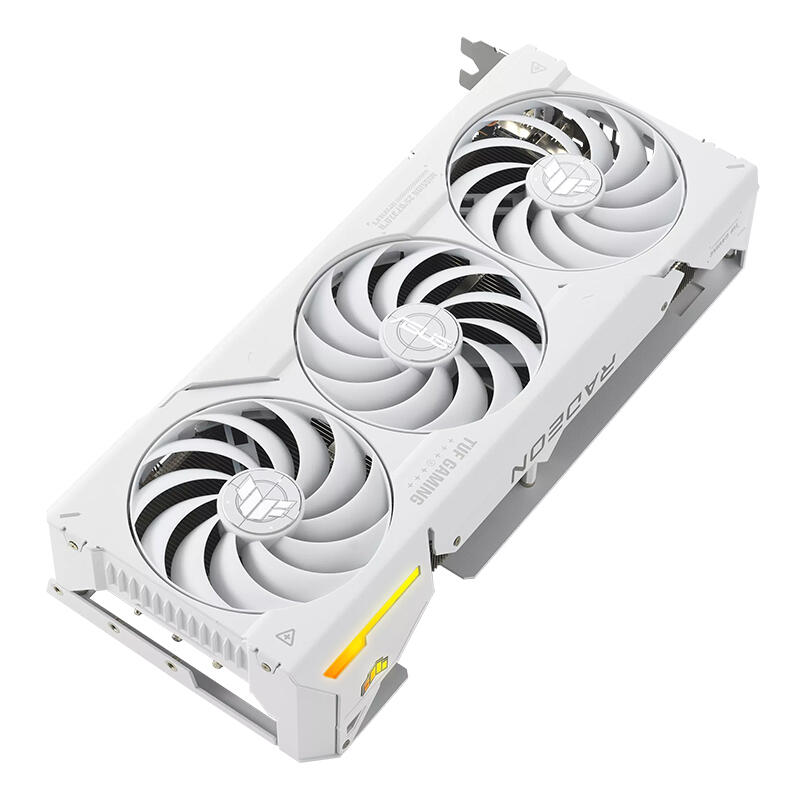
Earlier this year, ASUS supplied us with parts to put together a benchmarking PC so we can provide you with more consistent reviews. The original build, housed in an ASUS A21 Micro-ATX Case, included the ASUS ROG Strix Z790-I Gaming WIFI Motherboard, an ROG Strix LC III 360 AIO cooler, and the ROG Strix Gaming GeForce RTX 4070 OC Edition GPU.
However, they have helped us upgrade again, providing us with a new TUF Gaming GT302 ARGB Case in white, and the ROG Strix Z790-A Gaming WIFI II Motherboard, giving us a new system to test out the ASUS TUF Gaming Graphics card they sent with it – the 16GB GDDR6 AMD Radeon RX 7800 XT OC Edition in white.
As with all TUF Gaming hardware, the TUF Gaming AMD Radeon RX 7800 XT OC Edition is built with durability in mind. Power is delivered by military-grade capacitors, rated for 20,000 hours if the card is constantly running at 105 Celsius. This feels somewhat redundant, as three Axial-tech fans, mounted on Dual ball fan bearings, almost silently deliver up to 24% more airflow to critical components.
The outer casing, a simple but stylish metal frame coated in either white or black, offers a level of structural rigidity to help prevent warping, and it looks incredible while mounted in an all-white build. Additionally, should you mount it directly to a PCI Express 4.0 slot on your board, the TUF logo and small embellishment glow proudly with Aura Sync-compatible ARGB light, personalised through ASUS’s Armoury Crate App. While running with default settings the ASUS TUF Gaming AMD Radeon RX 7800 XT OC Edition will reach up to 2520MHz while boosted, however, this can be easily adjusted through ASUS’s GPU Tweak III software, where it can reach up to 2565MHz while in Overclock mode.
While running with default settings the ASUS TUF Gaming AMD Radeon RX 7800 XT OC Edition will reach up to 2520MHz while boosted, however, this can be easily adjusted through ASUS’s GPU Tweak III software, where it can reach up to 2565MHz while in Overclock mode.
Additionally, it comes with AMD’s RDNA Architecture, where 60 AMD RDNA 3 Compute units further enhance your gaming experience through RT+AI Accelerators, as well as proprietary software, such as AMD Software: Adrenaline Edition app, AMD FidelityFX and Radeon Super Resolution technology, making for an incredibly immersive experience.
While I only run two monitors, one being Ultra-High Definition, and the other being Full High Definition, the ASUS TUF Gaming AMD Radeon RX 7800 XT OC Edition can support up to four, connected through a single HDMI 2.1 and three DisplayPort 2.1 sockets. This will support a maximum resolution of up to 7680 x 4320, but I found the sweet spot to be 2560 x 1440, also referred to as Quad High Definition.
This was tested while playing the newly released Warhammer 40,000: Space Marine II. My usual system, running an RTX 2060S, will typically sit at 50 FPS while playing on the high settings in FHD. If I switch to my 4K monitor and adjust to QHD, I’ll usually sit at around 35 FPS, both of which are comfortable to play at.

With the benchmark PC, supplied by ASUS, I experienced an average of 110 FPS while playing on FHD, with Steam reporting up to 75 FPS while I played on QHD, although this was pushing past the limits of my 60Hz 4K UHD monitor. Switching out to the ASUS TUF Gaming AMD Radeon RX 7800 XT OC Edition GPU, I was excited to see that I was averaging 115 FPS while playing on my FHD 165Hz monitor, with Steam reporting an average of 80 FPS with the QHD Resolution.
I also decided to give 4K gameplay a chance, which is not something I have attempted using my usual gaming PC. The ASUS TUF Gaming AMD Radeon RX 7800 XT OC Edition managed to maintain a consistent 50FPS, whereas the RTX 4070 dropped down closer to 40FPS. These patterns where the ASUS TUF Gaming AMD Radeon RX 7800 XT OC Edition took a marginal lead remained consistent through upscaling tests, only falling behind the RTX 4070 during 4K UHD testing.
The ASUS TUF Gaming AMD Radeon RX 7800 XT OC Edition surprised me. I’ve always been a bit of an Nvidia Fanboy, so I wasn’t expecting to be as impressed as I am. It’s been crafted with both function and form in mind. Military-grade electronics and precision-engineered components can withstand even the most intense gaming sessions. While they perform admirably out of the box, easy-to-use software lets you squeeze more potential out of them.

The Good
- Great out-of-box performance
- Clean and elegant design
- Quiet cooling system
- Easy to increase performance
The Bad
- 4K upscaling wasn’t as rewarding








